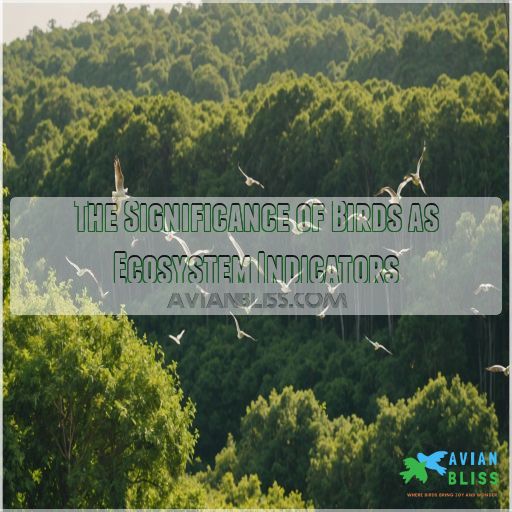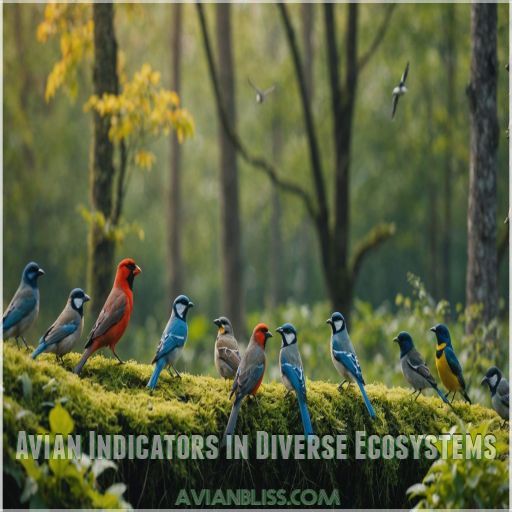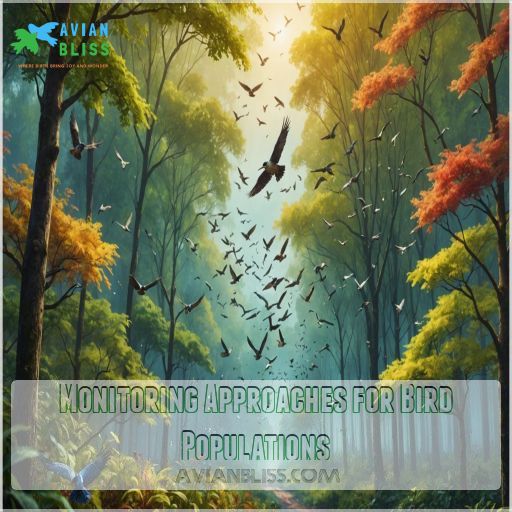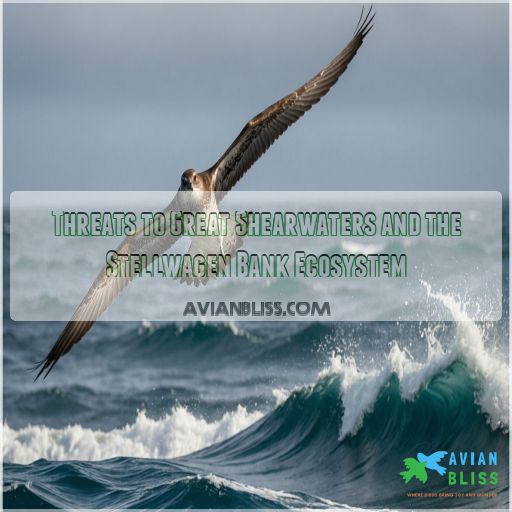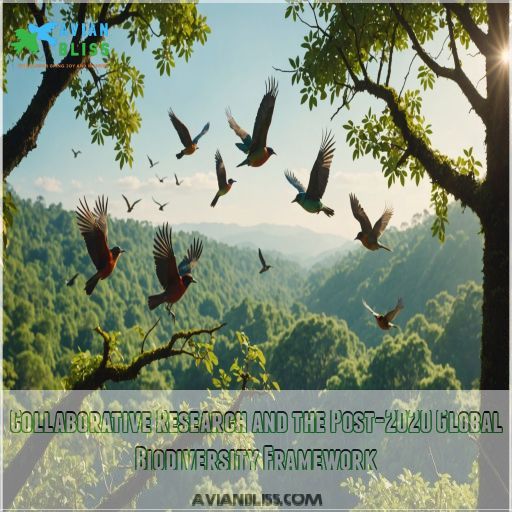This site is supported by our readers. We may earn a commission, at no cost to you, if you purchase through links.

By keeping an eye on our feathered friends, we can get a real sense of how healthy the habitats around us are doing. These winged wonders are so sensitive to environmental changes that their behavior and population trends act as a reliable indicator of an ecosystem’s well-being.
Whether it’s the forests, floodplains, or the open ocean, tracking key bird species gives us an early warning system to detect issues and take action to protect the delicate balance that sustains all life on Earth.
Keeping our avian sentinels happy and healthy is the key to a thriving planet.
Table Of Contents
- Key Takeaways
- The Significance of Birds as Ecosystem Indicators
- Characteristics of Effective Indicator Bird Species
- Avian Indicators in Diverse Ecosystems
- Monitoring Approaches for Bird Populations
- Great Shearwaters as Indicators of Stellwagen Bank Ecosystem Health
- Threats to Great Shearwaters and the Stellwagen Bank Ecosystem
- Collaborative Research and the Post-2020 Global Biodiversity Framework
- Frequently Asked Questions (FAQs)
- What makes birds such a valuable indicator of ecosystems health?
- How do birds act as environmental indicators?
- What is the best indicator of the health of an ecosystem?
- Why are birds so important to the ecosystem?
- How do birds indicate ecosystem health in coastal regions?
- What are the best practices for using bird monitoring to guide habitat restoration?
- How do declining regional bird populations impact global population stability?
- What bird species are most sensitive to saline lake habitat changes?
- How can citizen science programs contribute to bird conservation efforts?
- Conclusion
Key Takeaways
- By keeping an eye on birds, you’re essentially serving as nature’s health inspector. Their presence and behavior provide clues about the state of the environment before major issues arise. Think of them as the ‘canaries in the coal mine,’ but outdoors!
- Birds aren’t just eye candy; they’re the nerdy show-and-tell of ecosystems, revealing everything from pollution levels to the success of habitat restoration. A vibrant bird community is like your habitat’s report card: the higher the diversity, the better the grade!
- Choosing the right "focal species" is key to efficient monitoring. Pick birds that respond predictably to environmental changes—like nature’s very own, cost-effective, living sensors—giving you a heads-up on what’s happening out there.
- Don’t underestimate the power of birdwatching! Raising awareness and involving communities through birdwatching can be as delightful as it is impactful. You’re not just watching birds; you’re rallying a community of eco-advocates who help keep the planet thriving!
The Significance of Birds as Ecosystem Indicators
Birds are the unsung heroes of ecosystem health. Their sensitivity to environmental changes makes them reliable indicators, helping us understand habitats and track restoration progress.
Sensitivity to Environmental Changes
As sensitive barometers of environmental change, birds’ behavior and populations reveal ecosystems’ well-being.
From seasonal shifts in migration patterns to alterations in nesting sites and food sources, this feathered cohort serves as an early warning system for emerging threats like .
Tracking their adaptations helps us safeguard the habitats we all depend on.
Representing Habitat Quality
Often regarded as feathered sentinels, birds serve as reliable indicators of habitat quality.
By observing the diversity, abundance, and behaviors of avian species, you can gain valuable insights into the overall health and functioning of an ecosystem.
Whether monitoring pollution levels or tracking restoration progress, the presence and vibrancy of bird communities offer a telling reflection of environmental conditions, and can be used to track restoration progress.
Monitoring Restoration Efforts
When restoring ecosystems, monitoring birds provides a reliable gauge of progress.
By tracking species diversity and reproductive success, you can validate if your efforts are truly revitalizing habitat.
Birds flourish in healthy environments, so their presence signals you’re on the right track, indicating that you’re making progress in truly revitalizing habitat.
Raising Public Awareness
Beyond their essential roles in ecosystems, birds captivate us with their beauty and behavior.
By rallying communities to birdwatch, host educational events, and collaborate with conservation groups, we can cultivate greater appreciation for the feathered sentinels that signal ecosystem health.
Raising public awareness empowers everyone to protect the birds that enrich our world.
Characteristics of Effective Indicator Bird Species
When figuring out how healthy an ecosystem is, not all birds are created equal.
Researchers rely on "focal species" – native birds that are highly responsive to environmental changes and cost-effective to monitor.
Providing valuable insights into the overall condition of a habitat is the key role of these species, making them a crucial part of the research process in understanding the ecosystem’s health.
Focal Species Concept
Focal Species Concept identifies birds that represent the desired conditions of an ecosystem. These "indicator" species are strategically selected based on their responsiveness to environmental factors and cost-effectiveness of monitoring.
Prioritizing focal species allows land managers to efficiently track ecosystem health and guide conservation efforts.
- Select focal species that:
- Reflect overall habitat quality
- Respond predictably to environmental changes
- Provide cost-effective monitoring data
Responsiveness to Environmental Factors
You’ll be impressed by how quickly birds can reveal environmental changes.
As finely-tuned members of their ecosystems, their behaviors and populations readily reflect shifts in habitat quality, food resources, and even disease outbreaks.
That’s why they make such valuable indicator species – responsive sentinels that can alert us to looming troubles.
Cost-Effectiveness of Monitoring
Monitoring birds is a cost-effective way to gauge ecosystem health – it provides insights on the pulse of expansive landscapes from just a few observation points.
By strategically deploying proven techniques like point-count surveys, you can gather reliable data while maximizing your budget (Source).
Adopting a rotating monitoring approach after initial benchmarks are set can boost efficiency over time (Source).
Avian Indicators in Diverse Ecosystems
Birds are versatile sentinels, revealing the health of diverse ecosystems like floodplains and forests.
Their populations can guide us in gauging the effectiveness of habitat restoration and the impacts of forest management practices.
Monitoring Floodplain Health
Keeping a close eye on feathered friends can reveal the pulse of floodplain ecosystems.
Observe how:
- Prothonotary warblers thrive in wetlands with balanced hydrology
- Beach-dependent species like turtles and shorebirds signal shifts in flood patterns
- Frugivores’ feeding habits and reproduction hint at ecosystem changes
By tracking these avian indicators, you can stay ahead of threats to these important natural areas.
Assessing Early-Seral Forest Development
A trio of early-seral forest dwellers – the rufous hummingbird, willow flycatcher, and orange-crowned warbler – reveal the nuances of forest restoration.
By tracking their populations, you can gauge the success of reforestation efforts and make sure diverse habitats thrive, not just canopy closure .
Key metrics to monitor include:
| Metric | Threshold |
|---|---|
| Shrub Cover | >30% |
| Snag Density | >5/acre |
| Downed Wood | >10 tons/acre |
| Hardwood Species | >20% of trees |
| Breeding Success | >1.0 fledglings/pair |
Insights From Timber Harvest Practices
As birds respond differently to timber harvesting, studying their populations offers invaluable insights.
The Black-and-White Warbler, Nashville Warbler, and Common Yellowthroat, for instance, thrived after selective logging, while mature-forest birds were largely retained .
By monitoring these feathered indicators, you can gauge the health and resilience of your local ecosystems, using them as invaluable insights.
Monitoring Approaches for Bird Populations
Monitoring the health of avian populations is essential for understanding the state of ecosystems.
From point-count surveys to mist-netting and bird banding, researchers employ diverse techniques to track bird abundance, productivity, and survival – revealing key insights about the environments they inhabit, including understanding the state of ecosystems through monitoring of bird abundance.
Point-Count Surveys
Point-count surveys are a staple in the birder’s toolkit, allowing you to systematically document the feathered residents of an area.
By standing still and tallying every bird you see and hear, you can paint a vivid picture of avian abundance and diversity over time .
Just be mindful of factors like weather, time of day, and observer bias that can influence your counts, and remember that these surveys are an effective way to monitor the feathered residents.
Mist-Netting and Bird Banding
Mist-netting and bird banding reveal a treasure trove of insights about our feathered friends.
By gently capturing and carefully studying birds, researchers can uncover the secrets of their movements, health, and survival .
This invaluable data empowers us to protect and conserve these winged indicators of ecosystem well-being .
Measuring Productivity and Survival
Monitoring birds’ productivity and survival is key to understanding their health and populations. By analyzing capture-recapture data, you can uncover important statistics like annual survival rates, recruitment, and nest success – essential clues to environmental changes. These metrics paint a more complete picture than just counting birds alone.
- Capture-recapture analysis reveals age- and sex-specific survival
- Ratios of adults to juveniles estimate annual productivity
- This data can guide management decisions and conservation efforts
Great Shearwaters as Indicators of Stellwagen Bank Ecosystem Health
Great shearwaters are the unsung heroes monitoring the health of Massachusetts’ Stellwagen Bank National Marine Sanctuary.
By tracking these seabirds’ migration patterns and foraging habits, researchers can gauge the availability of their critical prey – sand lance – and assess the overall health of this vibrant, yet vulnerable, ocean ecosystem.
Reliance on Sand Lance Forage
As seabirds like the great shearwater rely heavily on sand lance, a small forage fish.
The Stellwagen Bank sanctuary team monitors their population trends.
Declines in this key food source could signal major disruptions to the entire ecosystem, underscoring the important role these birds play as sentinels of environmental change.
This highlights the important role these birds play in the ecosystem.
Tracking Migration Patterns
By tracking the epic migrations of these elusive seabirds, researchers gain invaluable insights into the Stellwagen Bank ecosystem.
Through satellite tagging, scientists follow the great shearwaters’ 500-mile weekly travels , revealing how climate-driven changes impact their key food source – the humble sand lance.
Coupling With Oceanographic Data
Pairing seabird migrations with ocean data provides a dynamic view of Stellwagen Bank’s health.
By tracking where great shearwaters forage, scientists can pinpoint shifts in prey abundance and predict how climate change impacts this important sanctuary .
This data-driven approach helps safeguard the sanctuary’s delicate balance for future generations.
Threats to Great Shearwaters and the Stellwagen Bank Ecosystem
Great shearwaters and Stellwagen Bank’s delicate ecosystem face grave threats from climate change.
As ocean temperatures rise, sand lance – the shearwaters’ primary food source – may vanish, forcing these seabirds to seek new foraging grounds.
Climate Change and Ocean Warming
As the world’s oceans continue to warm due to climate change, the great shearwaters of Stellwagen Bank National Marine Sanctuary may face an uncertain future.
Rising temperatures and ocean acidification can disrupt the delicate balance of their marine ecosystem, threatening the availability of their primary food source – the sand lance.
Researchers closely monitor these seabird sentinels to stay ahead of the curve and protect this diverse, vibrant sanctuary, which is an important part of the marine ecosystem.
Shifting Prey Availability
The shifting availability of sand lance, the forage fish central to the Stellwagen Bank ecosystem, is a growing concern.
As climate change alters ocean conditions, great shearwaters must adapt their foraging behaviors to locate sparse prey populations .
Monitoring these seabird sentinels provides important insights into the sanctuary’s ecological challenges.
Community-Based Solutions
With the threats of climate change and shifting prey looming, community-based solutions are essential for protecting the Stellwagen Bank ecosystem.
Local conservation groups, citizen scientists, and beachcombers can team up to restore habitats, monitor migrations, and share data.
All of this can be done while fostering a sense of shared ownership over this natural wonder, specifically its iconic great shearwaters.
Collaborative Research and the Post-2020 Global Biodiversity Framework
Monitoring the health of ecosystems takes collaboration. Researchers are teaming up to track birds and other indicators, providing essential data to support the Post-2020 Global Biodiversity Framework’s goals.
Interdisciplinary Partnerships
Forging interdisciplinary partnerships is key to tackling global biodiversity challenges.
By pooling expertise and resources, researchers can uncover novel insights and develop innovative solutions .
Collaborative efforts that involve diverse stakeholders – from policymakers to local communities – are essential to ensuring the post-2020 biodiversity framework delivers tangible impacts .
Join forces, amplify your impact!
Biodiversity Loss and Ecosystem Collapse
The impacts of biodiversity loss and ecosystem collapse can no longer be ignored.
A recent review found an alarming 2.5% annual decline in insects, fueling the decline of birds and other wildlife .
While challenging, restoration efforts in places like Cyprus prove a coordinated, community-based approach can help ailing bird populations bounce back . This shows that with the right approach, community-based approach can be effective.
Monitoring Framework and Indicators
As the world races to protect our planet, the post-2020 biodiversity framework needs robust indicators that capture ecosystem health at every level.
By partnering with avian experts, we can leverage birds as sensitive sentinels, revealing essential insights to guide conservation efforts and engage the public.
Let’s listen to our feathered friends – they hold the keys to a nature-positive future, and can serve as a guide for conservation efforts.
Frequently Asked Questions (FAQs)
What makes birds such a valuable indicator of ecosystems health?
Birds are the canaries in the coal mine – their delicate dance through the skies reveals the hidden story of our ecosystems.
By tracking their flight, we can see the pulse of nature itself.
How do birds act as environmental indicators?
You can think of birds as the canaries in the coal mine – their populations and behaviors reveal a lot about the health of the ecosystems they inhabit.
From tracking pollution to monitoring restoration efforts, birds are invaluable environmental indicators.
What is the best indicator of the health of an ecosystem?
Don’t get bogged down in a single indicator – ecosystem health is best understood by considering a variety of measures, from habitat condition to species diversity.
A balanced approach gives you the full picture.
Why are birds so important to the ecosystem?
Did you know birds eat up to 500 tons of insects per year, keeping crops and gardens healthy?
They’re the unsung heroes of our ecosystems, helping reduce disease, spread seeds, and pollinate plants.
Taking care of our feathered friends is important for a thriving planet.
How do birds indicate ecosystem health in coastal regions?
Birds are excellent indicators of coastal ecosystem health – their migrations and foraging patterns reflect changes in prey populations, water quality, and environmental factors.
That impact the entire marine food web. (Source)
What are the best practices for using bird monitoring to guide habitat restoration?
Focus on consistent, long-term data collection for changes in bird populations and habitats.
Use standardized protocols and adaptively manage habitat restoration based on findings.
Collaboration with experts enhances accuracy and guides better restoration strategies .
How do declining regional bird populations impact global population stability?
Declining regional bird populations throw a wrench in global stability by disrupting ecological webs, similar to losing a key jigsaw piece.
They affect species interdependencies and signal broader environmental concerns.
What bird species are most sensitive to saline lake habitat changes?
Did you know? Around 30% of species could face extinction due to climate change.
Avocets and phalaropes are quite sensitive to changes in saline lake habitats, often relying on specific salinity levels for feeding and breeding.
How can citizen science programs contribute to bird conservation efforts?
citizen science programs empower you to actively participate in bird conservation.
By collecting data on sightings and behavior, you help scientists track populations and study migration.
You also address threats like climate change—like becoming a bird superhero!
Conclusion
So, what’s the "tweet" of the day for understanding ecosystems? Birds as indicators of ecosystem health, that’s what!
By tuning into their songs and patterns, you’re tapping into nature’s own alarm system. Observe these winged wonders, and you can spot the early signs of environmental shifts.
You’re not just watching birds; you’re safeguarding our planet’s future, one feather at a time, because healthy bird populations mean a thriving world.
It can be a bustling forest or a serene sea, but either way, the birds are a key indicator.

